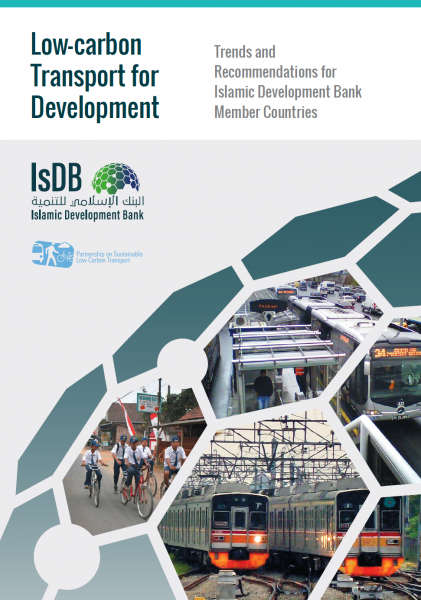New IsDB-SLoCaT Report on Low Carbon Transport for Development
The Islamic Development Bank (IsDB) and the Partnership on Sustainable, Low Carbon Transport (SLoCaT) release a new report on low carbon transport in IsDB member countries. The report shows major challenges and needs, potential transport policy activities and areas of required action.
The report can be downloaded here (and high-resolution version here).
Islamic Development Bank member countries’ challenges and needs
Islamic Development Bank (IsDB) member countries (MCs) face a number of challenges, including rapid urbanization, rising motorization rates, growing greenhouse gas emissions, climate change vulnerabilities, upstream capacity constraints and limited pipelines for infrastructure projects. Infrastructure stock in IsDB MCs is relatively low compared to population and increasing transport demand; therefore, more infrastructure for public transport, and especially urban rail systems, is a critical need.
In a business-as-usual scenario, transport emissions in IsDB MCs are projected to double between 2020 and 2050, and current mitigation ambition is insufficient in sub-regions/income groups with rapid growth. The majority of the projected growth in emissions among IsDB MCs up to 2050 is expected among those that are currently at lower emissions levels, and few IsDB MCs have developed long-term emissions reduction strategies.
A diversity of transport conditions is observed within each IsDB sub-region and income group; thus, detailed policies must be defined around emerging groupings (e.g. the transport sector’s share of carbon dioxide emissions is projected to increase most significantly in Southern Asia and Western Africa, and to decrease significantly in Western Asia). Therefore, a set of balanced transport and climate change solutions must consider specific country conditions complemented by sub-regional and income group characteristics.
At the same time, robust transport data are lacking for key indicators in many IsDB MCs; much potential analysis is thus constrained by data availability. There are few reliable data on passenger and freight transport activity (e.g. passenger- and ton-kilometres by mode and in total), and aggregated information on mode share in cities is not widely available in IsDB MCs.
Analysis of policy areas and responses
This report addresses the needs and challenges described through seven areas of analysis. A primary recommendation for each of these areas is given below, with supporting trends, best practices and recommended actions spelled out in more detail in the ‘Conclusions and recommendations’ section.
- Transport drivers and demand: The projected growth in motorization in IsDB MCs must be aggressively countered with a balanced set of measures to stabilize and reduce car ownership and use.
- Transport emissions: Rising emissions across IsDB sub-regions must be coupled with broad and balanced investments in lowcarbon mobility options which bring significant and more equitable long-term, economy-wide benefits.
- Transport mitigation (policy responses): To make a proportional contribution to Paris Agreement targets, more ambitious mitigation action is needed for transport in IsDB MCs.
- Transport adaptation (policy responses): Adaptation and resilience measures must be mainstreamed in transport systems, as the infrastructure and services of most IsDB MCs are highly vulnerable to the impacts of climate change, especially in low-income countries and coastal/island states.
- Urban transport: Investments in urban mass transit in IsDB MCs must be accelerated to keep pace with the projected growth in urbanization.
- Passenger and freight transport: Sustainable freight transport requires further attention and investment in IsDB MCs, especially landlocked countries with high freight-to-passenger transport mode shares.
- Road safety: The number of road traffic accidents in IsDB MCs is rising at alarming rates, and bold and rapid action is needed to increase road safety measures.
General conclusions and areas for future work
The analysis in this report has yielded a number of general conclusions to support the specific recommendations:
- Priority issues require urgent action in several IsDB sub-regions (e.g. rail and green freight development in Central Asia, urban transport in Western Africa) and in highly populated and rapidly urbanizing middle-income countries, to be tailored to landlocked, coastal and island states.
- It is possible to design pathways for transport in developing countries to be both a driver for inclusive development and to offer benefits for climate change mitigation and adaptation.
- Integrated chain responses are needed to address challenges such as booming motorization (e.g. a shift to public transport, coupled with a shift to e-mobility and the associated necessary renewable power generation).
- Technical assistance is needed to strengthen data-collection processes and address data gaps in various sub-regions (ideally through concerted efforts among multilateral development banks and bilateral donors).
- IsDB is uniquely positioned to play a key role in helping MCs transition to a sustainable development pathway through increased provision of low-carbon transport.
The analysis also suggests several areas for future research and action to transform responses to transport and climate change among IsDB MCs:
- Expand analysis of transport adaptation actions in Nationally Determined Contributions (NDCs), National Adaptation Plans and National Adaptation Programmes of Action to identify gaps in peer country plans (e.g. extension of Gambia’s recommendations to other sub-Saharan countries).
- Expand analysis of passenger and freight transport by selecting representative countries in each sub-region to determine an optimal mix of climate change mitigation and adaptation actions for each. QQ Assess the steps involved in developing regional versions of the Global Macro Roadmap on Decarbonizing Transport for IsDB sub-regions, and identify potential cooperating partners in countries with the highest emissions growth rates.
- Identify national and local transport ‘climate champions’ in MCs, and extend the impact of their efforts through engagement in global and regional networks related to urban transport (e.g. the Transport Decarbonisation Alliance).
- Facilitate the development of secondgeneration NDCs and long-term emissionsreduction strategies through joint action of transport and climate change divisions (in conjunction with the United Nations Framework Convention on Climate Change, the Partnership on Sustainable, Low Carbon Transport and other relevant groups).
